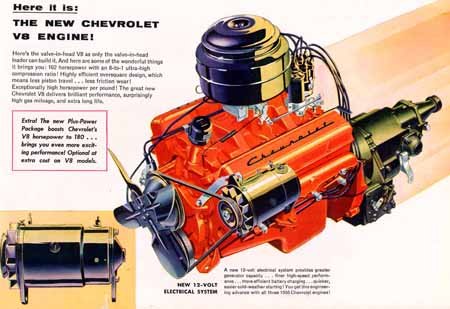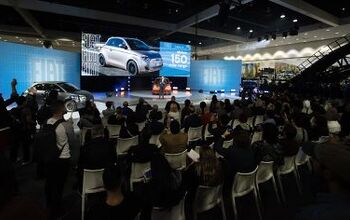Question: What Ten-Year Period Was the Auto Industry's Greatest Leap Forward?

Once I get to ranting on the subject, I’ll fulminate that the true modern era of the automobile didn’t start until about 1990, when carburetors and points ignitions finally disappeared from new cars sold in the United States. Before and after that point, however, a lot of progress— and backsliding— has taken place in the automotive industry. Which brings up the question: what ten-year period, starting with Karl Benz’s Patent Motorwagen in 1886, saw the most improvement, innovation, whatever you want to call it, in the automotive world?
You may choose to give most emphasis to advances in engineering and materials, in which case the advances made by GM and its rivals during the 1946-1956 period might be most important. Or maybe Mr. Ford’s greatest hit and resulting huge lowering of the cost of a new car could give the win to 1909-1919. European cars sure looked beautiful from, say, 1958 through 1968, and you can’t write off the bang-per-buck advances in build quality accomplished by Japanese automakers during the 1975-1985 period. But wait— how about electronic fuel injection and engine controls, which became standard equipment on even the lowliest econoboxes during the 1980s? And do we even consider any period containing 1939-45, a period during which the major carmaking countries were too busy blasting one another to crap to do much automotive innovation, but which produced a lot of engineering advances that went into cars later on? Or, what the heck, we’re living in the Golden Age of Ridiculous Horsepower right now— could be that 2003-2013 gets your vote! Your thoughts?

Murilee Martin is the pen name of Phil Greden, a writer who has lived in Minnesota, California, Georgia and (now) Colorado. He has toiled at copywriting, technical writing, junkmail writing, fiction writing and now automotive writing. He has owned many terrible vehicles and some good ones. He spends a great deal of time in self-service junkyards. These days, he writes for publications including Autoweek, Autoblog, Hagerty, The Truth About Cars and Capital One.
More by Murilee Martin
Latest Car Reviews
Read moreLatest Product Reviews
Read moreRecent Comments
- Ajla Maybe drag radials? 🤔
- FreedMike Apparently this car, which doesn't comply to U.S. regs, is in Nogales, Mexico. What could possibly go wrong with this transaction?
- El scotto Under NAFTA II or the USMCA basically the US and Canada do all the designing, planning, and high tech work and high skilled work. Mexico does all the medium-skilled work.Your favorite vehicle that has an Assembled in Mexico label may actually cross the border several times. High tech stuff is installed in the US, medium tech stuff gets done in Mexico, then the vehicle goes back across the border for more high tech stuff the back to Mexico for some nuts n bolts stuff.All of the vehicle manufacturers pass parts and vehicles between factories and countries. It's thought out, it's planned, it's coordinated and they all do it.Northern Mexico consists of a few big towns controlled by a few families. Those families already have deals with Texan and American companies that can truck their products back and forth over the border. The Chinese are the last to show up at the party. They're getting the worst land, the worst factories, and the worst employees. All the good stuff and people have been taken care of in the above paragraph.Lastly, the Chinese will have to make their parts in Mexico or the US or Canada. If not, they have to pay tariffs. High tariffs. It's all for one and one for all under the USMCA.Now evil El Scotto is thinking of the fusion of Chinese and Mexican cuisine and some darn good beer.
- FreedMike I care SO deeply!
- ClayT Listing is still up.Price has been updated too.1983 VW Rabbit pickup for sale Updated ad For Sale Message Seller [url=https://www.vwvortex.com/members/633147/] [/url] jellowsubmarine 0.00 star(s) (0.0) 0 reviews [h2]$19,000 USD Check price[/h2][list][*] [url=https://www.ebay.com/sch/i.html?_nkw=1983 VW Rabbit pickup for sale Updated ad] eBay [/url][/*][/list] Ceres, California Apr 4, 2024 (Edited Apr 7, 2024)


































Comments
Join the conversation
1947-1957. Guys came back from the war. Colleges were attended,people got married, families got raised, subdivisions got built. New cars got bought every two years. Cars looked fast standing still. Real hard to find an ugly new car in 1957. Harley Earle has a spring in step and a twinkle in his eye. You couldn't help but make money. Stories I've heard from old guys while drinking cocktails.
This is actually a more complicated question than it might seem. Why? Simply because various facets and capabilities of cars had different "leap-forward" cycles that did not necessarily overlap or become congruent with one another. Here are some, not necessarily in any order: 1) ICE vs Steam and early Electric; 2) Computerization and fuel injection; 3) Infotainment and touchscreen systems; 4) Safety protocols and airbags; 5) Automatic transmissions and air-conditioning; 6) Pollution controls and the CO2/SO2/NOx regulations; 7) The "nanny" era (ABS, ATC, ASC, lane-departure warning, blind spot, pedestrian detection, etc.) 8) Self-driving cars with passive occupants (new). I'm sure there are others. But the question is not when they occurred, but which are among the most influential? In my view, that simply can't be answered...yet, if ever. Perhaps all were(are) important. -------------------